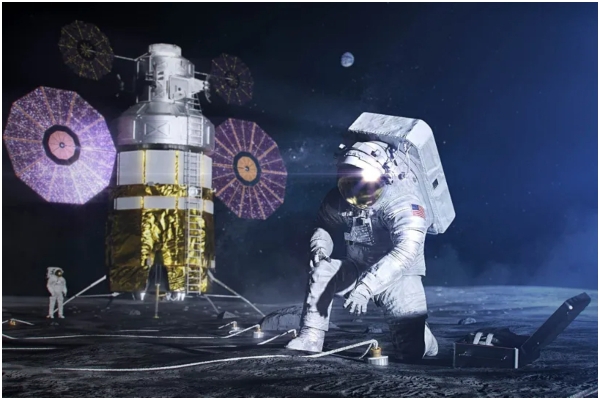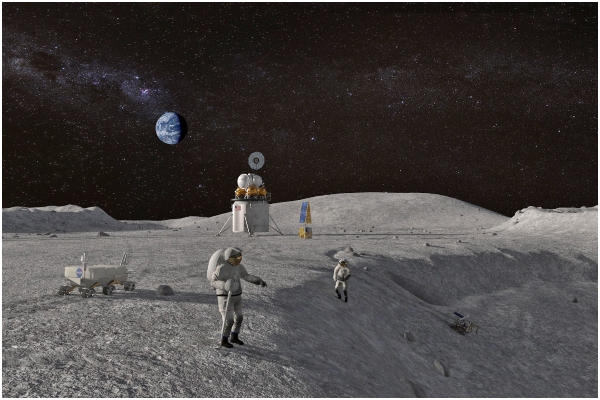A Case for Indian Space Advisory Group
Total Views |
The U.S.’ sway on the international interest for human presence and operations on the Moon has been reiterated with the initial success of its Artemis Accords. Eight of U.S’ strategic partners – Australia, Canada, Italy, Japan, Luxembourg, United Arab Emirates and United Kingdom – have agreed to formally participate in the Artemis Accords. Although India, France, Russia, and Germany share cordial space relations with the U.S., none of these three space-capable countries are part of this agreement.
The Artemis Accord can spawn best-practices and codes of conducts, in terms of lunar human and robotic presence and operations, which will suit the common goals of the alliance. But on the other hand, there is a latent possibility that a contra alliance with competing goals will come up, potentially led by China. In all likelihood, selenopolitics (the geopolitics of the Moon) is fast becoming an extension of terrestrial geopolitics.

The 2011 Chinese Exclusion Policy of the National Aeronautics and Space Administration (NASA) has been sharpened due to the ongoing U.S.-China Cold War. China has single-mindedly focused on lunar exploration in the past thirteen years, which is evident from their five back-to-back Chang’e robotic missions to the Moon. Not stopping there, there are three Chang’e robotic missions planned until 2024, and China is planning crewed missions to the Moon by 2035. These frequent missions reflect the entire gamut of Chinese ambitions for the Moon. It intends to become the biggest beneficiary of the Earth-Moon connectivity megaproject that both the selenopolitical factions are vying for. This megaproject will include fast interplanetary transportation systems, space-stations, low-latency interplanetary telecommunications, lunar surface and low-altitude transportation, lunar surface power generation, lunar surface habitats for human presence, and other exploration infrastructure. Where the recently-publicized China Aerospace Science and Technology Corporation’s concept of Earth-Moon Special Economic Zone hints at this development, Artemis Accords related progress is making it explicit.
The U.S., including its Artemis Accord partners, has steadily ramped up public-private synergies in developing various aspects of the lunar connectivity infrastructure. Recently, the U.S.’ renowned industrial R&D institution Bell Labs, currently known as the Nokia Bell Labs, has come forth to provide mission-critical, robust and reliable telecommunications, 4G long-term evolution (LTE), infrastructure to be made operational on the Moon. Likewise, the U.S. Department of Energy has stepped in to provide robust power solutions, including the use of nuclear radioisotope thermoelectric generators, on systems and habitats that will come up on the Moon.
The U.S. benefits from its technically robust industrial labs and companies as it, even today, has an upper-edge over China which is yet to develop strong international partnerships. The falling global confidence about Beijing, following its lackadaisical COVID-19 pandemic outbreak management in 2020, are expected to affect its space diplomatic pursuits in the longer run. Though, China is attempting to build confidence by pursuing an accommodative lunar diplomacy with its Chang’e programme and has been able to attract payload and ground-station support from many European countries like Netherlands, Sweden, Germany, and France as well as from new space players like Saudi Arabia and Argentina. Where a strong Artemis-like China-led alliance seems unlikely, Beijing can perhaps engage many countries bilaterally by offering its technical competence and asserting economic might.
The lunar pasture is greening with every passing month, and India has neither been courted by the U.S. nor China. It is understood that where the U.S. respects and comprehends the extension of India’s strategic autonomy in outer space, China certainly is not interested in extending space partnerships with countries that do not concur with its geopolitical ambitions. In any case, India’s lunar aspirations continue to be mostly science driven and not contemporaneous with these fast-moving changes that have heavy involvement of industry and international partners. This article presents the following diagnosis and makes a pointed recommendation.

India’s both Chandrayaan missions, Chandrayaan-1 (2008) and Chandrayaan-2 (2019) have been contemporaneous in terms of basic scientific investigations with other space agencies. However, a science-driven lunar programme will not address the growing selenopolitical urgencies. India must garner greater experience of robotic and crewed operations on the Moon’s surface and become an important stakeholder in the construction of interplanetary connectivity infrastructure.
The Space Commission, India’s top-most space strategic decision-making committee, needs to be bolstered with a conjoined body – a National Space Advisory Group (NSAG) – that can carry out unconstrained, objective, and self-reliant analyses in India’s national interests and fill the strategy lacunae that are out of the bounds of ISRO’s science-driven mandate. The arrangement between the Space Commission and the NSAG can be made akin to the National Security Council and the National Security Advisory Board, where the two latter bodies are formed of non-governmental experts. The NSAG, can include technocrats, professionals from high-technology industries, professionals from applied scientific organizations, independent analysts and academics. It can be mandated to contribute with research and analyses for swifter and precision-driven decision-making that rests with Space Commission. The apex commission can further direct the agreed recommendations to the Department of Space, ISRO, Indian National Space Promotion and Authorization Centre (IN-SPACe) and New Space India Limited (NSIL) as well as the larger space science and technology ecosystem.
In the coming decades, the Moon is bound to host numerous exclaves belonging mostly to alliances. These exclaves will be built through domestic public-private synergies as well as those between allies. Space agencies will cede substantial tracts of R&D responsibilities to industries, startups and private institutions, to acquire a greater role of a regulator and facilitator. With this prognosis, an empowered NSAG can continuously monitor global space political, industrial, scientific and economic developments and assist the Space Commission and the Prime Minister’s Office in national interests in outer space. India’s planetary exploration plans must be augmented by concurrently developing an interplanetary infrastructure. That is where the future of global space economy lies.

